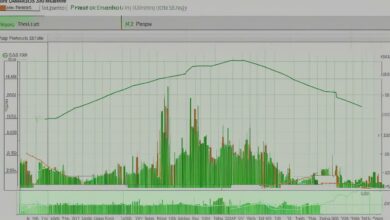Exploring the Seagull Option Strategy: Balancing Risk and Reward

Introduction
The Seagull Option Strategy is a sophisticated trading approach often utilized in options trading to manage price movements of an underlying asset. This strategy combines multiple option positions to balance risk and reward effectively.
Balancing risk and reward is crucial in trading. The Seagull Option Strategy provides traders with a way to hedge against unfavorable market shifts while still allowing for potential gains, making it a valuable tool in volatile markets.
To successfully implement the Seagull Option Strategy, it’s essential to understand various aspects of options trading, such as the Option Greeks, which measure the sensitivity of an option. The most common Greeks in options trading are Delta, Gamma, Theta, Vega, and Rho.
Additionally, traders should consider the different types of options brokers available, as this can significantly influence their trading experience and outcomes.
This guide targets:
- Options traders looking to diversify their strategies.
- Investors aiming to protect their portfolios.
- Beginner traders seeking structured approaches to mitigate risks.
By leveraging strategies like the Seagull Option Strategy and understanding key concepts such as the Black Scholes Model, which revolutionizes options pricing in modern finance, traders can navigate the complexities of the market with greater confidence.
Understanding the Seagull Option Strategy
The Seagull Option Strategy is a sophisticated trading approach that balances risk and reward by combining multiple options positions. At its core, this strategy involves three main components:
- Covered Call: Selling an at-the-money call option.
- Long Call: Buying an out-of-the-money call option.
- Protective Put: Purchasing an in-the-money put option.
These components work collectively to create a net credit position. Here’s how they interact:
- The covered call generates premium income from selling the call option, providing immediate credit.
- The long call offers potential for upside gains if the underlying asset’s price increases significantly.
- The protective put acts as a safety net, offering downside protection by allowing you to sell the underlying asset at a predetermined price.
The interplay between these elements results in a strategy that can capture upward price movements while offering some degree of protection against adverse market conditions. This combination helps to manage risk effectively without incurring significant upfront costs.
By understanding how these components interact, you can utilize the Seagull Option Strategy to navigate various market conditions with a balanced approach to risk and reward.
Exploring Options Styles
It’s important to note that the execution of these strategies can be influenced by the style of options you are dealing with. The style of an option defines when it may be exercised, which is a crucial aspect of options trading. We distinguish between American, European, and Bermuda options styles depending on their exercising rules.
For instance, American style options can be exercised at any time before expiration, providing more flexibility. On the other hand, European style options can only be exercised at expiration, which may influence your strategy depending on market conditions. Understanding these nuances can significantly enhance your trading effectiveness when utilizing strategies like the Seagull Option Strategy.
Market Outlook for the Seagull Option Strategy
Ideal market conditions play a crucial role in the effectiveness of the Seagull Option Strategy. This strategy thrives in scenarios characterized by a neutral to moderately bullish outlook. When you anticipate limited price movements, the Seagull Option Strategy can be particularly advantageous.

Ideal Market Scenarios
1. Neutral Outlook
The strategy works well when you expect the underlying asset’s price to remain relatively stable. Selling an at-the-money call option can generate premium income while buying an out-of-the-money call option provides upside potential. During such periods, market makers also play a crucial role in options trading, providing liquidity and facilitating smoother transactions.
2. Bullish Outlook
In slightly bullish markets, this strategy can capture some upward movement. Purchasing an out-of-the-money call allows for gains if prices rise, while the sold at-the-money call limits potential profits, creating a balanced risk-reward scenario.
Moderate Volatility
Moderate volatility significantly influences the effectiveness of this strategy.
- Risk Management: Moderate volatility ensures that the premiums collected from selling options are sufficient to offset those spent on purchasing options, maintaining a net credit position. In such scenarios, delta hedging with straddle options can be explored as a strategy to manage risk in your options trading portfolio.
- Profit Potential: With controlled price fluctuations, the capped profit potential is often realized without substantial risk exposure.
In summary, implementing the Seagull Option Strategy in neutral or slightly bullish markets with moderate volatility allows you to balance risk and reward effectively. For instance, keeping an eye on stock market news could provide valuable insights into market movements that influence your trading decisions.
Step-by-Step Construction of the Seagull Option Strategy
Understanding the step-by-step construction of the Seagull Option Strategy is crucial for effectively implementing it. This section provides an in-depth guide on constructing this strategy from scratch, using Stock XYZ as an illustrative example.
Detailed Process for Constructing the Strategy
To construct a Seagull Option Strategy, follow these steps:
- Select the Underlying Asset: Identify the asset you wish to trade options on. For this example, we’ll use Stock XYZ.
- Determine Market Outlook: Assess whether you expect the market to be bullish or bearish.
- Choose Strike Prices:
- Bullish Configuration:
- Buy an Out-of-the-Money (OTM) Call Option: Select a strike price above the current price of Stock XYZ.
- Sell an At-the-Money (ATM) Call Option: Choose a strike price close to the current price.
- Buy an In-the-Money (ITM) Put Option: Pick a strike price below the current price.
- Bearish Configuration:
- Buy an OTM Put Option: Choose a strike price below the current price.
- Sell an ATM Put Option: Select a strike price close to the current price.
- Buy an ITM Call Option: Pick a strike price above the current price.
Example Construction Using Stock XYZ
Let’s walk through an example using Stock XYZ, currently trading at $100, in a bullish configuration.
- Buy OTM Call Option:
- Strike Price: $110
- Premium Paid: $2
- Sell ATM Call Option:
- Strike Price: $100
- Premium Received: $5
- Buy ITM Put Option:
- Strike Price: $90
- Premium Paid: $12
The net premium collected is calculated as follows:
Net Premium = Premium Received from ATM Call – (Premium Paid for OTM Call + Premium Paid for ITM Put) = $5 – ($2 + $12) = $5 – $14 = -$9
This results in a net debit position of $9 per share or $900 for one contract (since one option contract typically represents 100 shares).
Key Considerations
- The maximum profit potential occurs if Stock XYZ rises to or just above the sold ATM call’s strike price ($100). Here, you benefit from both the appreciation of the long call and protection from the put option.
- The maximum loss is capped by the bought put option at $90, providing downside protection.
- Profit is limited due to the sold call option at $100, capping gains beyond this point.
The Seagull Option Strategy offers a structured approach to balancing risk and reward through strategic selection of strike prices and understanding underlying assets like Stock XYZ.
Profit and Loss Potential of the Seagull Option Strategy
Maximum Profit Calculation
To achieve maximum profit, the underlying asset’s price must be at or above the strike price of the sold call option at expiration. In this scenario, all options expire worthless except the sold call, which will be exercised. The net credit received from selling options contributes to the profit.
Example:
- Bought Call (Out-of-the-Money): Strike Price $110
- Sold Call (At-the-Money): Strike Price $100
- Bought Put (In-the-Money): Strike Price $90
If the stock closes at or above $100, only the sold call is exercised. The maximum profit is determined by the net premium collected when constructing the strategy. This is a good example of how a call option can be utilized in such strategies.
Maximum Loss Scenarios
The maximum loss occurs if the underlying asset’s price falls below the strike price of the bought put option at expiration. Both bought options will be in-the-money while the sold call expires worthless. The loss equates to the difference between the strike prices of the out-of-the-money call and in-the-money put, minus any net premium received.
Example:
- Bought Call: Strike Price $110
- Sold Call: Strike Price $100
- Bought Put: Strike Price $90
If Stock XYZ closes at $90 or below, losses are capped by the put’s intrinsic value minus received premiums.
Capped Upside Due to Short Call Position
The upside potential is capped because of the short call position. When you sell a call option, you agree to sell shares at a predetermined price if exercised. This limits your gains beyond this strike price since any substantial upward movement results in delivering shares at that fixed price. It’s important to understand that you can sell a call option before its expiry date, which could provide some flexibility in managing this risk.
However, traders should also be aware of certain market indicators that may not always provide accurate signals. For instance, there are limitations of the MACD indicator, including its dependence on historical data and potential for false signals.
Key Takeaways:
- Maximum Profit: Achieved when underlying stays between strike prices of bought call and sold call.
- Maximum Loss: Occurs if underlying drops below bought put’s strike.
- Capped Upside: Due to obligations from selling a call option.
Understanding these elements can help traders manage their expectations and risks when implementing a Seagull Option Strategy.
Opportunities and Benefits of the Seagull Option Strategy
The Seagull Option Strategy, an example of an exotic option, offers several opportunities and benefits, making it a compelling choice for traders looking to balance risk and reward.

Income Generation Potential
This strategy enables income generation through multiple premium sources. By selling at-the-money call or put options, you collect premiums that can offset the cost of buying other options in the strategy. This structure allows for a potentially net credit position, providing an immediate income stream. For insights into how traders achieve consistent profits using such strategies, this interview with an options trader provides valuable information.
Risk Management Features
One of the standout features is its ability to manage risk effectively. The bought out-of-the-money option acts as a hedge against adverse price movements, providing downside protection. This mitigates potential losses while allowing for gains within a specified range.
Flexibility and Customization
The Seagull Option Strategy is highly flexible and can be customized to fit individual trading needs. You can adjust strike prices and expiration dates to align with your market outlook and risk tolerance. This adaptability makes it suitable for a variety of market conditions, from stable to moderately volatile environments.
By leveraging these features, traders can achieve a balanced risk-reward profile, making the Seagull Option Strategy a versatile tool in any trading arsenal. To fully understand the intricacies of such strategies and their associated financial instruments, it’s essential to have a firm grasp on [understanding financial derivatives](https://www.fxoptions.com/understanding-financial-derivatives). These are financial instruments that have become integral to modern finance, with their value derived from the performance of underlying assets.
Challenges and Considerations in Implementing the Seagull Option Strategy
Implementing the seagull options strategy comes with its own set of challenges. Understanding these obstacles can help you navigate them more effectively.
Downside Risk Exposure
One significant challenge is the downside risk exposure from the short put position. If the underlying asset’s price falls significantly, the short put can lead to substantial losses. To mitigate this:
- Use stop-loss orders: Automatically sell your position if it hits a certain price, limiting potential losses.
- Diversify your portfolio: Spread investments across different assets to reduce reliance on a single position.
- Hedge with other instruments: Use additional options or futures contracts to offset potential losses. For instance, implementing a synthetic long options strategy could provide some level of protection against downside risks.
Importance of Market Timing
Market timing plays a crucial role in the success of the seagull options strategy. Poor timing can lead to unfavorable outcomes, reducing profitability. Effective market timing involves:
- Technical analysis: Utilize charts, trends, and indicators like moving averages or RSI (Relative Strength Index) to identify optimal entry and exit points.
- Economic indicators: Pay attention to economic reports and news that could impact market volatility.
- Historical data: Study past performance of similar market conditions to predict future movements.
Complexity of Managing Multiple Options Positions
Managing multiple options positions adds complexity, requiring active management and close monitoring. Key considerations include:
- Regular monitoring: Frequently check positions to ensure they align with your strategy and make adjustments as needed.
- Software tools: Leverage trading platforms and software for real-time data analysis and automated alerts.
- Education and training: Continuously improve your understanding of options strategies through courses, books, and webinars. For example, exploring resources such as the 10 best books on options trading can significantly enhance your knowledge.
The seagull options strategy demands careful planning and execution. Addressing these challenges head-on will enhance your ability to balance risk and reward effectively while also considering other strategies like the iron butterfly or understanding option moneyness, which are valuable in advanced trading scenarios.
Case Studies: Seagull Option Strategy in Action
Case Study in Stable Market Conditions
In a stable market, the Seagull Option Strategy can effectively generate steady income. Consider Stock XYZ, currently trading at $100. A trader anticipates minimal movement over the next month. Here’s how the strategy could be structured:
- Buy 1 out-of-the-money (OTM) put option at a strike price of $95.
- Sell 1 at-the-money (ATM) put option at a strike price of $100.
- Sell 1 OTM call option at a strike price of $105.
For simplicity, assume the following premiums:
- Premium paid for the $95 put: $2
- Premium received for the $100 put: $4
- Premium received for the $105 call: $3
This setup results in a net credit of $5 ($4 + $3 – $2). If XYZ remains around $100, both the short put and short call expire worthless, allowing the trader to keep the net premium collected. This strategy benefits from little to no movement in stock price, providing steady income without significant risk exposure.

Case Study in Slightly Bullish Market
When anticipating a slight upward movement, the Seagull Option Strategy can capture gains while managing risks. Using Stock XYZ again, now trading at $100 and expected to rise moderately:
- Buy 1 OTM call option at a strike price of $105.
- Sell 1 ATM call option at a strike price of $100.
- Buy 1 ITM put option at a strike price of $95.
Assume these premiums:
- Premium paid for the $105 call: $1.50
- Premium received for the $100 call: $4
- Premium paid for the $95 put: $0.50
Here, the trader receives a net credit of $2 ($4 – ($1.50 + $0.50)). If XYZ rises to approximately $102 by expiration, the sold ATM call incurs minimal loss while other options expire worthless or unexercised. This allows retention of most of the net premium and leverages slight bullish movements effectively.
Both scenarios illustrate how different market conditions impact strategy outcomes, highlighting its flexibility and income generation potential.
However, it’s important to stay updated with latest stock market news, as it can significantly influence trading strategies and outcomes.
In addition, understanding concepts like intrinsic value (https://www.fxoptions.com/intrinsic-value) is crucial when dealing with options. The intrinsic value of an option is essentially the difference between the current price of the underlying asset and its strike price.
Moreover, traders should also be aware of factors such as decreasing implied volatility (https://www.fxoptions.com/decreasing-implied-volatility), which can have significant consequences on their investment portfolio. It’s vital to explore strategies that help manage risks and maximize returns in such volatile market conditions.
Conclusion
The Seagull Option Strategy is a powerful tool for balancing risk and reward in trading. It allows you to protect yourself from unfavorable price changes while still being able to profit within a specific range. This strategy is especially useful in unpredictable markets.
Here are some key benefits of the Seagull Option Strategy:
- Income generation: By using multiple option contracts, you can earn income from different sources.
- Downside protection: The strategic placement of options provides protection against potential losses.
- Flexibility and customization: This strategy can be tailored to suit your individual trading needs.
By adopting this approach, traders gain a versatile tool that can help them succeed in various market conditions.
To further improve your trading performance with the Seagull Option Strategy, it’s important to also focus on mastering intraday options trading strategies. These strategies can complement your existing knowledge and skills, leading to even better results.
For more information on how to enhance your intraday options trading techniques, check out our guide on mastering intraday options trading strategies.







